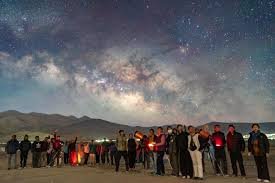HANLE (LADAKH), August 3, 2025 : In the remote border village of Hanle in Ladakh, a group of young residents is turning to the night sky in search of a brighter future. As the country’s first Dark Sky Reserve (HDSR), Hanle has become a beacon for astro-tourism — and the village’s youth, now trained ‘astro-ambassadors’, are at the heart of this cosmic journey.
Located near the India-China border, Hanle boasts some of the clearest and darkest skies in the country. It is home to the Indian Astronomical Observatory (IAO), operated by the Indian Institute of Astrophysics (IIA), and ranks among the ten highest optical observatories in the world.
Recognising Hanle’s unique potential, a 22-km radius around the village—within the Changthang Wildlife Sanctuary—was declared the Hanle Dark Sky Reserve in December 2022. The initiative, backed by a formal agreement between the Union Territory of Ladakh, LAHDC Leh, and the IIA, seeks to promote sustainable tourism while protecting the night sky from light pollution.
“We were invited to apply through our village heads. Forty of us applied, and 24 were selected,” said Rangdol Dorjey, one of the trained astro-ambassadors. “We received 15 days of training from IIA experts on telescope handling, identifying celestial bodies, and guiding tourists.”
Over 70% of the selected astro-ambassadors are women. Each participant was provided with an 8-inch telescope funded by the UT administration.
Hanle’s night sky is now drawing increasing numbers of tourists — not only for its wildlife or scenic beauty, but for the chance to witness the wonders of the universe. “Visitors are fascinated by the Milky Way, Saturn, Jupiter, and the Pole Star,” said Tsering Yangdol. “Stargazing is best between 9 PM and 11 PM, especially on moonless nights.”
Even cloudy skies don’t deter these skywatchers. “We wait till midnight sometimes—clouds usually clear up,” Yangdol added.
Though stargazing alone doesn’t yet provide enough income to fully sustain a family, the astro-tourism initiative has created new opportunities. “Some of us also run homestays, so being an astro-ambassador has definitely helped boost our earnings,” said Kesang Dorjey.
With growing footfall comes the responsibility of preserving Hanle’s pristine night environment. To this end, the HDSR Light Management Plan has been implemented, outlining measures to minimise light pollution. UT Ladakh has equipped local homes with thick curtains, warm light bulbs, and shaded lamps.
“Sustainable tourism committees have been formed. We hold community meetings and educate both locals and tourists about keeping light pollution in check,” Rangdol said.
As Hanle’s young ambassadors continue to guide eyes toward the heavens, they are not only unlocking the mysteries of the cosmos but also carving out a sustainable future for their community—one star at a time.



















